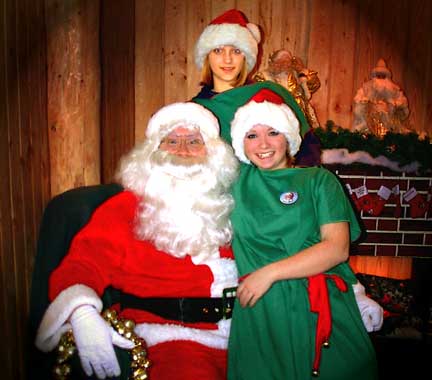|
Saturday morning at the Tisdale Mall our very own Jolly Santa Claus was ready to
meet and greet the children who would soon come and sit upon his knee to tell him
of their Christmas dreams.
The Tisdale Santa and the outstanding cooperation between the Tisdale Mall and various
organisations within the community, have an wonderful project to raise money and
those things that will make Christmas this year better for those in need.
On the television show "Will and Grace" this week there was the troubling
scene of the insipid homosexual guy praying to Santa. Then last night one of the
U.S. networks carried a TV movie dealing with a professor who had crashed his plane
while seeking to prove the existence of "flying reindeer".
Ever since Coca-Cola began using this familiar red jacketed bearded happy gift giver
in the nineteen thirties to advertise their product,, the myth of Santa Claus has
grown and extended into the folklore of the modern world. In Northern Europe the
Father Christmas, St. Nickolas character has been in contemporary culture and was
woven into the wonders of the Christian culture. The North American version has been
drastically upgraded and we really need to step back and give this myth a little
more consideration.
The need for humans of all ages to involve themselves in the mystical and spiritual
is simply part of being an intelligent being, faced with so many unknowns and so
many unexplainable elements in life. The predominance of Christianity in our culture
has always been under some pressure from other religions vying for acceptance and
it is entirely possible that the contemporary world, which has for various reasons,
stepped back from the confines of Christianity, is building a new religion,, albeit
a seasonal one. It is too wide spread to be considered a "cult," but with
its massive popular appeal and almost total acceptance by the public, it is a social
phenomena of more than eighty years in growing, developing and establishing itself.
I was nine and Dennis Leonard and I were strolling from the station to our house,
along the wood side walk in our little village and it was October. Dennis was a few
months older than me and always seemed like he was more aware and more tuned into
what the world was about. So it was that I asked my trusted friend, did he think
there really was a Santa Claus? Now, or even then, I am not sure if I meant, the
idea of this mythical being, for indeed, I had seen that in years past, the man called
Santa Claus, at the Christmas concert was Andy Bruce with a costume on, but for me,
the troubling issue, was there a "real" Santa Claus, somewhere out there,
beyond the telephone poles and railroad tracks, of the real world? Dennis, stumbled
with the answer, he knew I was deadly serious and he was faced with dealing with
his friend's earnest question.
I don't remember his answer, it wasn't the words that would stay with me, it was
the look on his face, the look of a ten year old struggling with reality.
Dennis was a good Catholic boy and I was a well brought up Protestant, both of us
grew up and have made our lives in this world and we have survived the Santa Claus
trauma. Mythic stories like "Yes Virginia" and "Miracle on 42nd Street"
have come and gone, but the nagging problem remains.
At Sunday School,, in church sermons, around the dinner table, the passion of Christmas,
what it really was all about, is rock solid in my mind and no doubt in Dennis' mind.
We know about the gifts of the Magi, we understand the joy of celebrating the arrival
of the Messiah, why then do those around us need to create a new religion, a conjured
creation of imaginary and pretty silly conjectures that have come to have such power
and influence when the "real" meaning of Christmas is so mysterious and
wondrous all in itself.
You of course know the answer. Christianity is far from universal and so remarkably
fractured that it is only natural that a folk tale would evolve to encapsulate the
spirit of Christmas without being Christian. We need to have this season at the end
of the year to refresh our sense of hope, to reach out to each other and share our
very best feelings, we need to show love, those ideals are confusingly tucked away
in the myths that are embodied in an overweigh middle aged guy with a red suit and
fake beard.
Ho. Ho. Ho!
Timothy W. Shire
|

